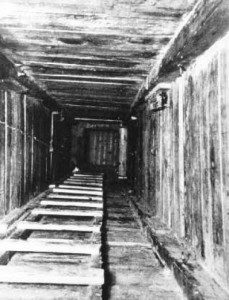
For the better part of three months, X Organization diggers had worked on their bellies, their sides, or their backs excavating the horizontal section of Tunnel “Harry” roughly 22 inches tall and 22 inches wide. But by March 12, 1944, the dig had returned to the vertical. Gingerly, just as Wally Floody had done downward in April 1943, they crafted an upward shaft that would give the escapers an exit from “Harry” into the woods beyond the wire.
At the upper end of their vertical shaft, Hank Birkland and the other diggers built a final solid box frame around four bedposts and a wooden ceiling. It was positioned right below some pine tree roots, to remain in place until the night chosen for the breakout.
They had tunnelled for eleven months – from April 11, 1943, to nearly the end of the second week of March 1944. They had removed and dispersed several hundred tons of sand from three major tunnels. Scrounging from every corner of the North Compound, kriegies had incorporated more than 4,000 bed-boards, 90 double bunk beds, 1,212 bed bolsters, 1,370 battens, 1,699 blankets, 161 pillow cases, 635 mattresses, 192 bed covers, 3,424 towels, 76 benches, 52 twenty-man tables, 10 single tables, 34 chairs, 30 shovels, 246 water cans, 1,219 knives, 582 forks, 478 spoons, 1,000 feet of electric wire, 600 feet of rope, and 69 lamps into “Tom,” “Dick,” and mostly “Harry.”
According to the measured ball of string the diggers unraveled in the tunnel, “Harry” covered 336 feet (nearly 400 feet including the two vertical shafts). The escape committee was just six inches away from the sod and roots of the forest floor, well outside the wire – six inches to freedom.